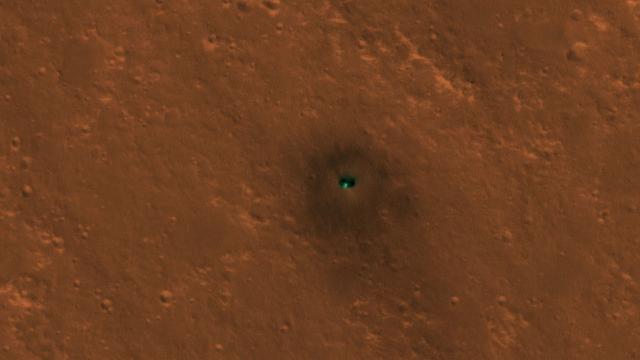The precise location of NASA’s InSight lander within Elysium Planitia is now known, thanks to images captured by the Mars Reconnaissance Orbiter.
The InSight lander touched down on the Martian surface on November 26, with NASA scientists confident it had settled somewhere along an 130km-long (130-kilometer-long) ellipse chosen as an ideal landing zone. But it’s exact location within Elysium Planitia—a flat lava plain just north of the Martian equator—wasn’t known until now.
NASA’s Mars Reconnaissance Orbiter (MRO), a satellite that’s been in orbit around Mars since 2006, scanned the Martian surface near the suspected landing area on December 6, then again five days later. Images taken by its camera, the High Resolution Imaging Science Experiment (HiRISE), revealed InSight’s location within the plain, along with the location of its discarded heat shield and parachute.
Some of the objects in the photos have a teal-like hue, which isn’t their actual colour. Light “reflected off their surfaces cause the colour to be saturated,” explains NASA in a release. This effect is what’s known as a specular reflection.
“It looks like the heat shield has its dark outside facing down, since it is so bright,” wrote the HiRISE team at its blog. “The lander disturbed dust over a fair distance and has darkened the surface, as seen previously at the Phoenix and Curiosity landing sites. The bright spot associated with the lander is probably another specular reflection, and there are two smaller bluish extensions that are the solar arrays, plus their shadows.”
“The backshell attached to the parachute may have yet another specular reflection; the streak extending to the south well beyond the parachute is probably a pre-existing dust devil track,” writes the HiRISE team.
As noted, this isn’t the first time that HiRISE has captured images of a Martian landing site; the camera spotted the Phoenix landing site in 2008 and Curiosity’s in 2012.
The InSight project is still in its opening stages, with NASA scientists slowly testing and calibrating its many instruments. It appears that InSight landed in a suitable spot, where it’ll be able to use its seismometer and heat flow probe to study conditions below the Martian surface. NASA expects this to happen in about four to six weeks.
